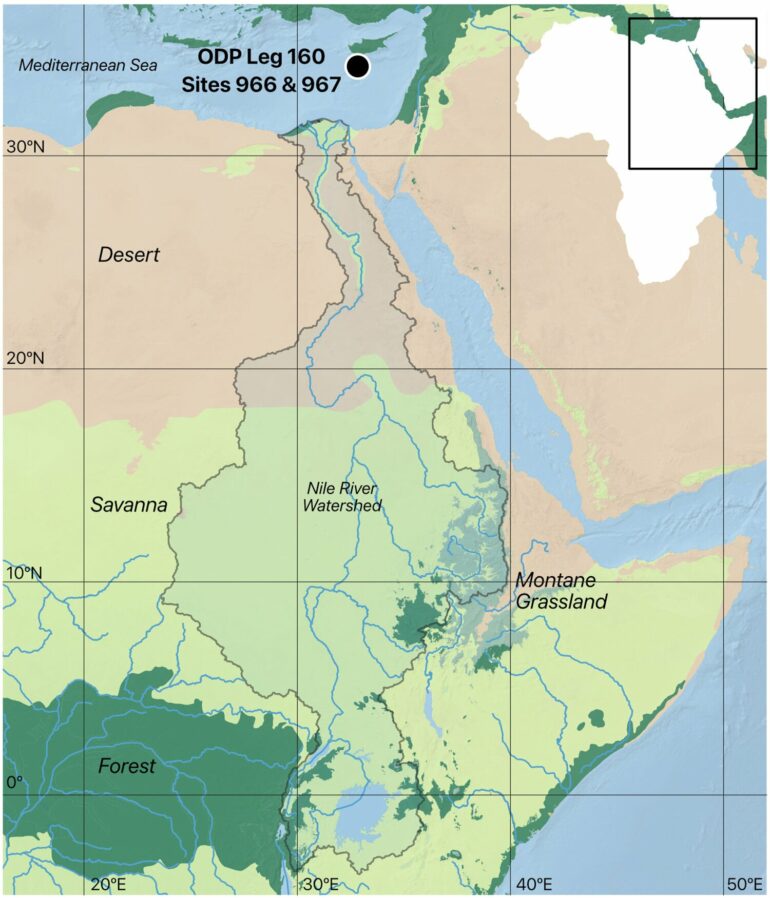About 6 million years ago, in the deep forests of eastern Africa, something spectacular happened. Chimpanzees, our closest relative in the animal kingdom, evolved in one direction, while our earliest ancestors continued in another.
Over the next millions of years, the differences between early humans and chimpanzees became greater and greater. Our ancestors climbed down from the trees, began to walk upright on two legs, and thus freed their hands to handle tools.
This was the beginning of a development that ended with humans conquering most of the globe.
About 2.1 million years ago, the first humans—Homo erectus—migrated from Africa. The journey went through northeastern Africa and the Middle East—areas that are mainly covered by desert today—and onwards to Europe and Asia.
For a long time, researchers have speculated on how Homo erectus could cross the dry and merciless desert, where there was neither food, water nor shade.
New research from Aarhus University now suggests that Homo erectus may not have walked through the desert when they left Africa, explains Rachel Lupien, who is one of the researchers behind the new results. The paper is published in the journal Communications Earth & Environment.
“We know that there are recurring periods when the climate in the Sahara changes. We call the phenomenon ‘Green Sahara’ or ‘African Humid Periods.’ During a green period, the desert shrinks significantly and is transformed into a landscape that resembles the savannas we know from eastern Africa today,” she says.
“Our results show that the Sahara, precisely in the period when the first Homo erectus migrated, was greener than at any other time in the 4.5 million year period we studied. They were therefore most likely able to walk through a green corridor out of Africa.”
The species who conquered the world
The first humans of the species Homo erectus appeared more than two million years ago in eastern Africa.
Homo erectus was the first hominin to learn to chisel axes out of stone. These axes were probably used as weapons to bring down prey and cut meat from the bones. They were probably also the first to learn how to control fire.
Homo erectus was slightly shorter than modern humans, but more muscular. They had wider hips and an elongated skull. In addition, they had a significantly smaller brain—about half as large as ours.
For more than 1.5 million years, Homo erectus lived and spread throughout much of the globe. From Africa to Europe, through Asia and across the Malacca Strait to several Indonesian islands. This makes the Homo erectus the longest-lived human species. Our species, Homo sapiens, evolved about 300,000 years ago.
The seafloor reveals the climate of the past
The Sahara, as we know it today, is in one of its dry periods. The duration of such a period varies, but approximately every 20,000 years, the continent has gone through a full cycle with both a rainy and a dry interval. These rainy periods are what Rachel Lupien referred to as “African Humid Periods.”
“How wet the humid green periods become, varies. There are indeed two other cycles that also come into play. One lasts 100,000 years and the other 400,000 years. Over the course of 100,000 years, the wet periods will thus vary and become wetter or drier than usual. The same applies in intervals of 400,000 years,” says Rachel Lupien.
But how can we actually know what the climate was like in Africa several hundred thousand years ago?
The seafloor can tell us, and we actually already know a lot about the climate of the past for this exact reason, she explains. “Using core samples from the Mediterranean, we can see what the climate was like millions of years back in time. Layers of sediment are formed on the seafloor, and small molecules in these layers can tell us quite a bit about what the climate was like in the past.”
Help from substances that make the leaves shine
Help from substances that make the leaves shine. Over time, new layers are formed on the seabed with material that blows from northern Africa and out over the sea, where it slowly descends. The buried seabed thus acts as a kind of logbook that can tell us what the climate has been like back in time.
In the layers there are a suite of biomarkers that store information about the climate of the past. One of these markers is a series of molecules that plants use to protect their leaves. They are also called leaf wax, explains Rachel Lupien.
“Wax gives leaves on trees, bushes and grasses the coating that makes them shine. When the plants die, most plant parts decompose quite quickly, while wax molecules can survive for a long time. That’s why we often find such molecules in sediments that are millions of years old.”
It is the chemical composition in the wax molecules that can tell something about what the climate was like when the layer was formed. For example, the hydrogen molecules in the wax can tell something about how much precipitation there was.
“Water contains hydrogen, so we can use hydrogen to follow the water cycle. The water on Earth contains both regular hydrogen and heavy hydrogen (deuterium). When it rains a lot, the plants are able to absorb relatively less heavy hydrogen, while when it is dry they absorb more,” she says.
Carbon holds important knowledge
Rachel Lupien and her colleagues can see from the amount of heavy hydrogen in the leaf wax when it rained a lot and when it was dry. However, hydrogen does not tell anything about which plants thrived in the wet climate.
The carbon atoms in the leaf wax do, however, she explains.
“Broadly speaking, there are two types of plants. We also call them C3 and C4 plants,” she says. “About 90% of all plants are C3 plants. They thrive in most parts of the globe except in areas that are bone dry or very hot. C4 plants, on the other hand, are specialized to survive in areas where rain rarely falls and the temperature is high.”
Because C3 and C4 plants produce leaf wax with different amounts of heavy carbon, researchers can distinguish between them in the samples. In this way, they can “read” which type of plant was most dominant at the time.
“At the time of Homo erectus’ migration from Africa, we found more C3 in the samples than in any other humid period in the last 4.5 million years. This shows that the wetter climate changed parts of the area from desert to grassland and savanna,” she says.
Three types of photosynthesis
In the plant kingdom, there are—broadly speaking—three different ways to perform photosynthesis. There are C3 and C4 plants—and a third variant, which is called CAM plants.
Some 90% of all plants are C3 plants, 6% are CAM plants and only between 3 and 4% are C4 plants. However, not in Africa, where the large grasslands have a much larger proportion of C4 plants.
The difference between the plants is due to their different coping strategies when moisture in the air and soil are limited.
When it gets too dry, C3 plants close the small stomata in the leaves, which they use to absorb CO2. With the holes closed, the plant cannot perform photosynthesis and begins to burn through its carbon reserves, while exhaling water and CO2. If this continues for too long, the plant dies.
C4 plants, on the other hand, are able to perform photosynthesis even when it is dry. Despite their stomata being closed, they continue to convert CO2 into energy. They can do this with the help of the molecule with four carbon atoms, of which the plant type is named. CAM plants use a third method, and can cope in even drier areas.
Wheat, oats, rice and sunflowers are examples of C3 plants. Known C4 plants are maize, sugar cane and amaranth, while succulents, cacti and pineapple are CAM plants.
Greenest 2.1 million years ago
The green periods in Africa occur, like the ice ages in northern latitudes, due to small variations in Earth’s orbit around the sun. Geologists call these variations Milanković cycles.
And it is particularly two of these variations that play an important role when the Sahara gets more precipitation, explains Rachel Lupien.
“The Earth wobbles a little bit in its orbit around the sun. It is this wobble that creates climate fluctuations every 21,000 years—and that causes the African Humid Period,” she says. “The other cause of the fluctuations is how circular the Earth’s orbit around the sun is. During some periods the orbit is more elliptical and during others more round. This causes fluctuations with about 100,000 and 400,000 years in between.”
The Sahara was at its greenest about 2.1 million years ago. Here, several of the cycles have most likely coincided to create such an environment. This coincides with when Homo erectus migrated. The climate has therefore most likely facilitated this migration, she concludes.
More information:
Rachel Lupien et al, Low-frequency orbital variations controlled climatic and environmental cycles, amplitudes, and trends in northeast Africa during the Plio-Pleistocene, Communications Earth & Environment (2023). DOI: 10.1038/s43247-023-01034-7
Citation:
Study suggests climate played a crucial role in human migration from Africa (2023, December 8)



